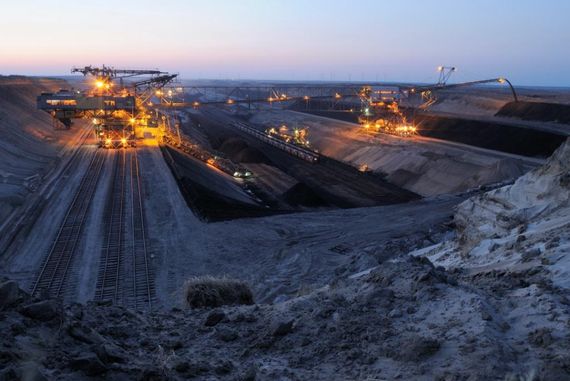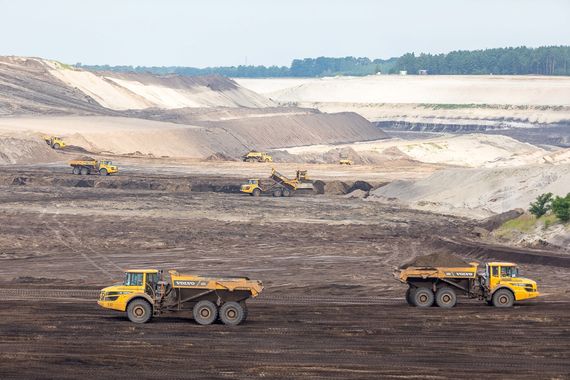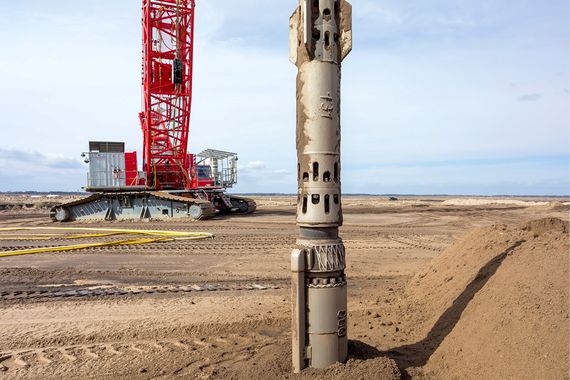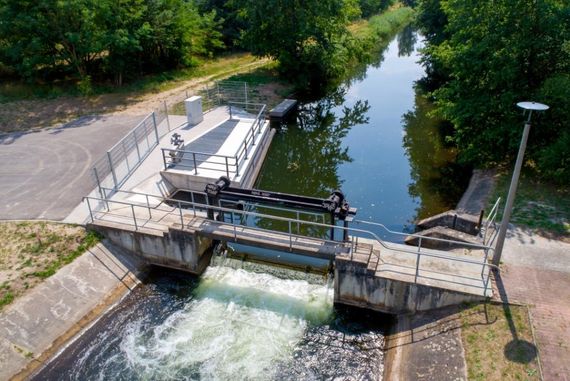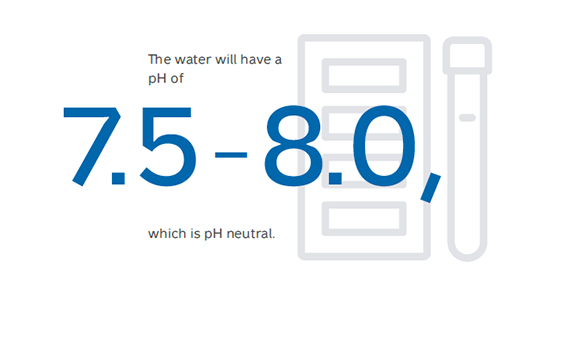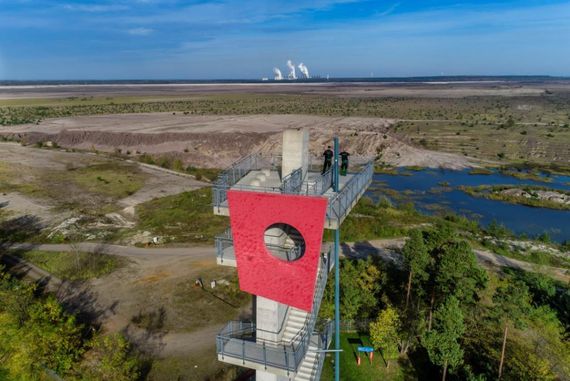Shift change in Cottbus-Nord opencast mine
After 30 years of lignite mining, the Cottbus-Nord opencast mine is transformed into a multi-purpose lake: the Cottbuser Ostsee. Construction measures of superlatives such as the shaping of the lake basin and the profiling of 26 kilometres of shoreline in total characterise the dimensions of the project.
In 2018, readiness for flooding the Cottbuser Ostsee was established. From April 2019, water can flow from the Spree to the lake basin. Thus, until the mid-2020s, the formerly smallest active opencast mine in Lusatia is beeing transformed into Brandenburg's largest inland water body and the largest postmining lake in Germany.
The Cottbus-Nord opencast mine
For over 30 years, Cottbus-Nord opencast mine as well as the neighbouring Jänschwalde opencast mine supplied the Jänschwalde power plant. Cottbus-Nord supplied about a quarter of the annual lignite requirements of the 3,000 megawatts power plant. The lignite seam in this mine was about 45 metres deep and up to 11 metres thick. The first preparations for the exploration of the opencast mine, including the lowering of the groundwater level, began in the mid-1970s. On 8 April 1981, the first coal train entered the power plant and the last one on 23 December 2015. With the scheduled completion of coal mining, a new stage in the development of the postmining landscape began for LEAG – the creation of a lake. It is primarily intended to serve as a leisure and holiday destination. In addition, the lake will be used for commercial fishing. The eastern shores are reserved for wildlife and nature.
Landscape after mining
The lake basin was modelled from the dumps of the Cottbus-Nord opencast mine, requiring extensive earthworks. In order to be able to start this work unhindered, the complete infrastructure of the opencast mine and all large-scale equipment had to be dismantled directly after mining ended. In the future centre of the lake, around 20 million cubic metres of dumped soil were redistributed to ensure the safe future utilisation such as boat traffic and fishing. The earth masses removed were used to backfill the former coal railway exit and to create Bärenbrücker Bucht (Bärenbrücker Bay). About 140 earthwork machines were used daily at the large construction site of the Cottbuser Ostsee.
Safe shorelines
The work on securing of the shoreline areas began parallel. For this purpose, the naturally grown shores in the south, west and north, which were not influenced by mining, were profiled and flattened. The eastern shore and its offshore islands were established using opencast mining equipment. Thereafter additional stabilisation measures were necessary. The well-proven technologies of vibrocompaction and drop-weight compaction were used to secure these banks, compacting the loosely deposited sands to depths of up to 50 metres. The resulting subterranean barrier is about 120 metres wide and has a total length of approx. 16 kilometres, a solid ground structure, giving the slopes of the shores lasting stability. A total of 46 million cubic metres of soil have been compacted in this way.
Water for the Cottbuser Ostsee
It has been permitted to withdraw more than 80 percent of the required water from the Spree River according to the approval of the State of Brandenburg. Less than 20 percent will originate from rising groundwater. Flooding is an integral part of regional water management in the Spree catchment area and is subject to fixed rules. When and how much Spree water may be discharged for the Ostsee is determined by weekly flooding control instructions.
These are issued by the Lusatian flooding control centre and agreed with the state authorities. The particular interests of the residents along the Spree River and the protection of its fauna and flora are taken into consideration. This means, water is only taken from the Spree when the river carries enough water. This will mainly be the case in the winter months or when summer floods occur.
17.04.2024 bis 23.04.2024
The flooding
Flooding started in April 2019. Current information about filling level and the share of Spree River water.
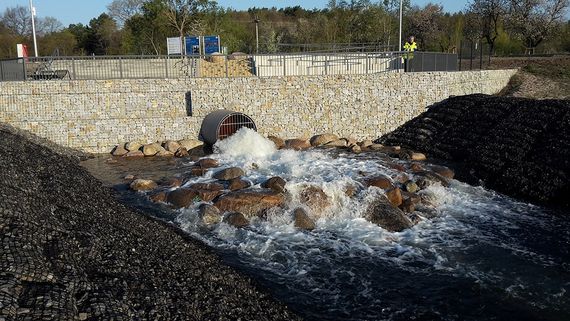
update: the water level is updated at the beginning of each month, an update of the flooding water quantity takes place weekly on Wednesdays, unless flooding is paused.
*In previous versions, the current water level of the Cottbuser Ostsee lake was given as a percentage. Due to various requests, we have made an update as of 23.11.2022 and now show the current water level, measured in the northern border cut of the former opencast mine.
Flooding with Spree River water
The flooding waters are withdrawn from the Spree via the Hammergraben at the level of the Lakoma weir. For the water withdrawal, a so-called "overflow structure" with a maximum capacity of 5,000 litres per second was erected. From there, the water flows through a subterranean feeder at a downward gradient to the inlet structure. The inlet structure is below a visitor´s platform. The water for flooding flows out of the pipeline of the feeder in a wide, flat channel over the bank and the remaining slope to the bottom of the former opencast mine. In the future, a steerable outflow structure for the lake, which is to be errected east of Willmersdorf, will ensure a connection to the regional water network via the Schwarzen Graben. It makes use of the natural gradient of the terrain.
By means of a special flooding management system using Spree River water and good quality groundwater, the Cottbuser Ostsee Lake is predicted to have a water quality which does not require additional improvement measures. Thus, even dry periods of several years in which the Spree holds little water can be managed. This has already been proven by measured pH values of t to 7.3. Lake Cottbus will have visibility depths of between six and eight metres.
Experience postmining landscape
Between the Spreewald in the north and the Seenland in the south, the Cottbuser Ostsee Lake sets a new destination on the map of Lusatia. The interest of the future "coastal towns" in opening up the lake for future tourist use is correspondingly high.
The ideas of the surrounding communities are very diverse. They range from the construction of ports and water skiing facilities to the development of cycle paths and infrastructure to the regulation of navigability.
Companies and universities are also looking into the potential of Germany's largest artificial lake to date.
The eastern shore of the lake offers unique areas for nature and landscape development. With its richly structured island and shallow water areas, it provides fauna and flora with individual habitats. Among others, waterfowl such as Bean geese and White-fronted geese, Grey herons and Great Crested Grebes, will find places to rest and hunting grounds for food.
A Cottbuser Ostsee tour
At the Cottbuser Ostsee Lake, a network of cycle paths is being created, that will connect the lakeshore areas with interesting sites to explore in the mining district and in the vicinity of the postmining landscape. With due caution, various lookout points can be visited during the flooding time. The "Fürst-Pückler-Radweg" leads from Cottbus directly to the edge of the former opencast mine. There are information boards at intervals, pointing out the change in the landscape with interesting information on mining and the regional history, for visitors following the future shoreline between Neuendorf, Merzdorf and Schlichow. A worthwhile destination for a great panoramic view is the lookout tower in Merzdorf. From a height of 30 metres, visitors have an impressive view showing the dimensions of the overall "Cottbuser Ostsee" project. A viewing platform directly above the water feeder awaits the guests at the inlet structure.
Warning during the flooding!
While the Cottbuser Ostsee Lake is being flooded, the shoreline and the future lake bed, the former inner dump, is out of bounds. There is a danger to life! As the water level rises, the inner dump in the centre of the lake is also immersed in the water. This causes the dumped sands to become unstable and they can abruptly slip into the deeper areas of the lake basin as a result.
The slipping sand displaces the water so fast that there is a danger of a several metres high wave reaching the shoreline. As the amount of water in the lake increases, these surge waves can also reach the flattened shore area. These processeshave been taken into account in the safety precautions established.
We kindly ask you, in your own interest, to take the safety instructions seriously! Only when the final water level is reached do the dump sands settle to such an extent that there is no more danger of surge waves. On the shore you can only feel the typical wave movements of the wind. The Cottbuser Ostsee Lake will be opened to the public after being released from mining law.
